and Peter M. Prendergast2
(1)
Elysium Aesthetics, Bogota, Colombia
(2)
Venus Medical, Dublin, Ireland
Introduction
The curves, slimness, and proportions of the female back play a key role in physical attractiveness. A slim waist, lumbar lordotic curve, and curvaceous hips define beauty and femininity and increase sex appeal (Fig. 14.1). With advanced lipoplasty, the idea is to create smooth, seamless contours, some definition of important anatomical landmarks, and a deep waist above the buttocks [1–6]. The hips should be contoured to improve curvaceousness and proportions, adding fat where necessary [7, 8]. Pay attention to the patient’s desires and expectations, since the results that are desirable often vary between patients, ethnicities, and age groups. For instance, a curvaceous hip is often requested in Latin or African-American patients, whereas Caucasians might prefer slimmer hips. As we mentioned in previous chapters, the aesthetic ideal and goal is to provide a waist-hip ratio of 0.7.
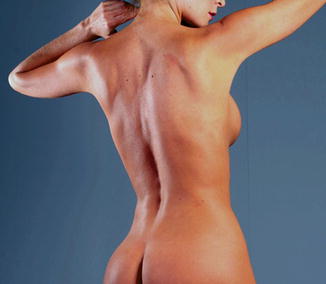

Fig. 14.1
Beautiful female form
In most books on body contouring, liposuction over the back is mentioned as an aside and has not been given the importance or attention it deserves [9]. As in all forms of sculpture, treating the surrounding areas is fundamental to achieving good definition and smooth transitions between each aesthetic unit. We use a systematic approach to achieve ideal female form, carefully addressing the flanks, dorsum, and hips so that the final result appears not simply better, but beautiful (Fig. 14.2).
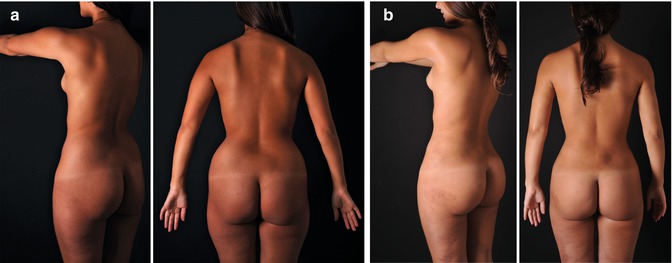

Fig. 14.2
A 22-year-old female patient preoperative (a) and 15 days postoperative (b)
Stealth Incisions
The back is an area of high exposure and scars in this area are difficult to conceal. For this reason, we need to place incisions in the natural folds where they are not likely to be seen when the patient wears a bathing suit. The use of special long cannulae allows us to reach the whole back without the need for extra back incisions. Additional incisions should be avoided as much as possible.
The ideal points for incisions should be (Fig. 14.3):


Fig. 14.3
Female dorsum incisions
1.
Axillary fold: One incision in the posterior axillary fold on both sides, strategically placed in the natural wrinkle of the fold at the posterior axillary line.
2.
Intergluteal crease: One incision is made in the superior part of the intergluteal crease in order to access the lower back and the gluteal spaces.
3.
Additional incisions: If the lower back and the flanks are difficult to reach with the intergluteal incision, we can place an extra incision at the bra-strap line, but we recommend this only for obese or secondary patients.
Warning!
Try to avoid as much as possible placing the central back incisions. There are two main indications for an extra incision in the exposed area of the back: heavy patients that have back rolls due to significant fatty deposits in the central back and secondary patients that have fat below the costal margin.
The Use of Drains
A drain, open or closed, is left in the sacral, intergluteal incision (Fig. 14.4).
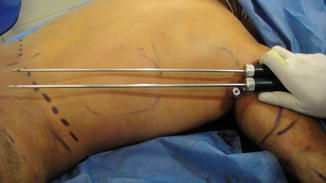

Fig. 14.4
Areas reached using long cannulae in the back
Markings
Deep Markings
Fat deposits are marked from the center to the periphery, extending superiorly and inferiorly from the point of maximum indentation (PMI). Back rolls are marked for aggressive liposuction (Fig. 14.5).
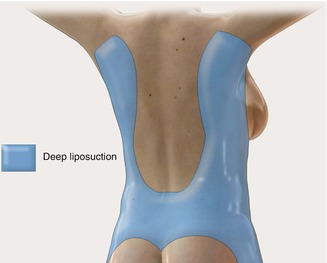

Fig. 14.5
Markings for deep extraction
Framing
Special markings are made in the flanks to enhance the waistline. The only framing point is the paired sacral dimples and the midline above the line between them. These markings define the posterior inferior iliac spines and paralumbar muscles, respectively. The lateral borders of the paralumbar muscles are palpated and marked with the patient standing and hyperextending the hips (Fig. 14.6).
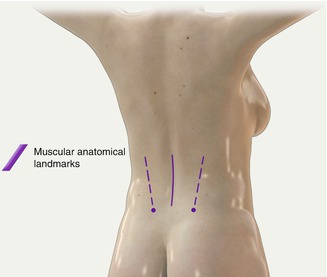

Fig. 14.6
Markings of the sacral dimples, muscular anatomical landmarks, and the midline for framing
Stay updated, free articles. Join our Telegram channel

Full access? Get Clinical Tree








